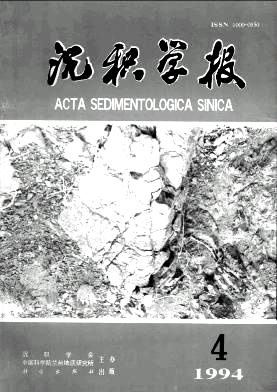Zhang Xiaobao, Fang Guoqing, He Haiqing. A Discussion on Main Characteristics and Origin of the Ripple Marks of Upper Triassic Turbidites in west Qinling Mts.[J]. Acta Sedimentologica Sinica, 1994, 12(4): 124-131.
| Citation:
|
Zhang Xiaobao, Fang Guoqing, He Haiqing. A Discussion on Main Characteristics and Origin of the Ripple Marks of Upper Triassic Turbidites in west Qinling Mts.[J]. Acta Sedimentologica Sinica, 1994, 12(4): 124-131.
|
A Discussion on Main Characteristics and Origin of the Ripple Marks of Upper Triassic Turbidites in west Qinling Mts.
- Received Date: 1994-02-16
- Publish Date:
1994-12-10
-
Abstract
For a long time, ripple marks were often regarded as one of sedimentary indicators of shallow water, but large quantities of them were also found in bathyal terrigenous elastic turbidites of Upper Triassic of west Qinling Mts. The ripple marks characterize that(1)they occour on the surface of Tc of Bouma sequence, which means that they were formed by tractive currents derived from turbidity flows, ( 2 ) they exist in the lobe facies associations of seafloor fan sequences, which indicates that the most favourable hydrodynamic }rtditions to form them appeared in outer fans,(3)they are all symmetrical,which shows that tractfve currents to form them were unidirectional, ( 4 ) They are smal l-scale,which proves that the veIocIty of tractive currents and the grain size of bottom bed sands varied in a certain extend,(5)their wavelengths and heights are directly proportional to the thickness of turbidites, which means that the strength of tractive currents was controlled by the scale and strength of turbidity flows, (6)the shapes of wave crests and troughs are smooth and the shapes of ripple ridges are regularly changeable , ( 7 ) their shapes and scales are closely related with those of ripple laminations in Tc intervals of Bouma sequences, which reflects that they were two forms of expression produced by the same tractive currents,(8 ) The flow directions determined by ripple marks are consistent with those determined by bottom marks,which reflects that the flow directions of tractive currents were controlled by those of turbidity flows. The characteristics above reflect that ripple marks occoured not only in shallow-water enviroments but also in deep water enviroments.
-
References
|
[1]
|
李继亮等.1978,我国几个地区浊积岩系的特征,地质科学,(1),26~44. |
|
[2]
|
孙枢、李继亮,1984,我国浊流与其它重力流沉积研究进展一概况和发展方向间题当议,沉积学报,2(1):1~7. |
|
[3]
|
甘肃省地矿局,1989,甘肃省区城地质志,地质出版社,239~243, |
|
[4]
|
殷鸿福等.1992,秦岭及邻区三盛系,中国地质大学出版社。 |
|
[5]
|
Mutti E. and Rica Luoati F. R.,1972, Turbidites of the northern Apennines, Introduction to fades analysis (English translation, 1978). Int. Geol. Rev.,V. 20, p. 125~166. |
|
[6]
|
Mutti E. and Normark W. R..1987. Comparing examples of modern and ancient turbidite systems; problems and concepts.in; J. K. Leggett and G. G. Zuffa (eds). Marine elastic Sedirttentology, conoepta and case studies. Graham and Trotman,Landon, p. 1~37. |
|
[7]
|
Seilacher A.,1967, BaVtymetry of trace Paenils. Mar. Geol.,No. 5 p. 413~428. |
|
[8]
|
Middleton, G. V. and Hampton, M. A. 1973. sediment gravity flows; Medumics of flow and deposition, Part I. In middleton, G. V. and Bouma. A. H. Cha. Turbidites and doep一water sedimentation:Ion Angeles, Calif. SEPM pacific section , short course lecture notes. p. 1 ~38. |
|
[9]
|
Simons, D. B.,Richardson, E. V. and Nordin, C. F. Jr.,1965, sedimentary structures generated by flow in alluvial, In Middleton, G. V. ed. Primary sedimentary structures and their hydradynamlc interpretation, Symposium; Tulsa, Okla.SEPM Spee. Pub. No. 12, p. 34~35. |
-
-
Proportional views

-






 DownLoad:
DownLoad: